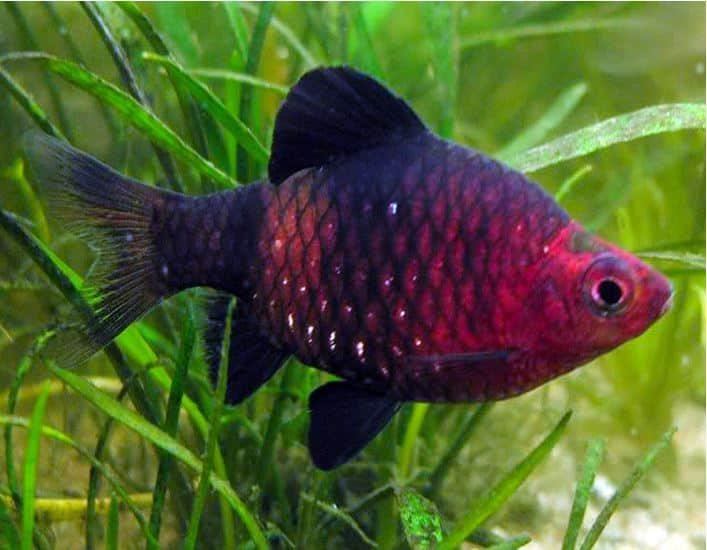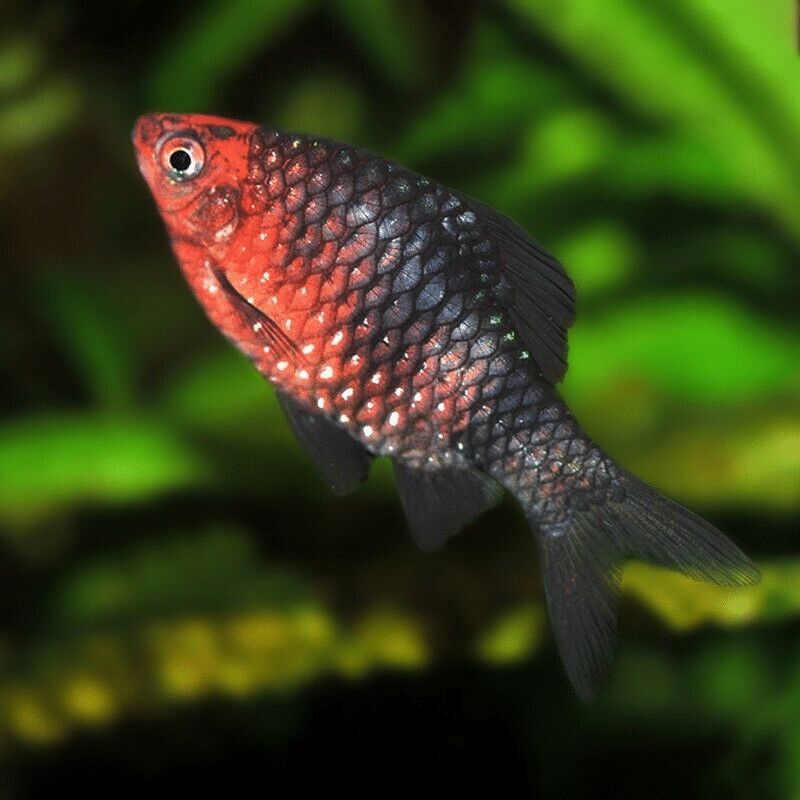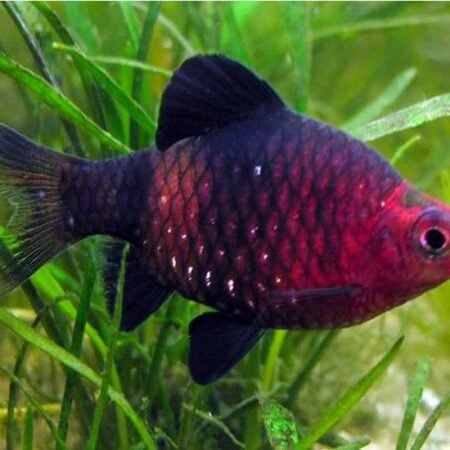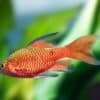Subtotal: £29.03
5 X Black Ruby Barbs – Pethia Nigrofasciata – Cyprinid Fish (5), Stunning Tropical Fish Thriving in Community Tanks for Enthusiasts Seeking Colorful Companions
£14.99 Original price was: £14.99.£12.58Current price is: £12.58.
Welcome these beautiful Black Ruby Barbs (5) into your aquarium! Their stunning black and red colors create vibrant charm, making them perfect for community tanks. These peaceful companions thrive in groups, showcasing graceful swimming and natural behavior. Ideal for aquarists seeking colorful fish.
1996 in stock
Species Introduction
The Black Ruby Barb, scientifically known as Puntius titteya, is a stunning member of the Cyprinidae family, originating from the freshwater streams and rivers of Sri Lanka. These beautiful tropical fish are characterized by their vibrant colors and peaceful demeanor, making them a popular choice among aquarium enthusiasts. In their natural habitat, Black Ruby Barbs thrive in densely planted areas with plenty of hiding spots, which provide them with a sense of security and comfort. They are known for their striking appearance, with males displaying a deep ruby red coloration that is particularly vibrant during breeding periods, while females are slightly more subdued in color but still possess a unique charm. Their maximum length reaches about 5 cm, making them an ideal choice for community tanks where space is a consideration.
Care Requirements Dashboard
Essential Care Guide for Your Black Ruby Barbs
| Optimal Living Conditions | |
|---|---|
| Water Temperature | 24-27°C (75-81°F) |
| pH Level | 6.5-7.5 |
| Water Hardness | 4-12 dKH |
| Minimum Tank Size | 80L (20 gal) |
| Salinity | Freshwater |
| Care Level | Beginner Friendly |
✓ Care level: Easy
| Care Requirement | Details |
|---|---|
| Tank Size | Minimum of 20 gallons |
| Water Temperature | 22-28°C (72-82°F) |
| pH Level | 6.0 – 7.5 |
| Hardness | 5-15 dGH |
| Social Behavior | Peaceful and social |
Natural Behavior & Temperament
Black Ruby Barbs are known for their active swimming patterns and social behavior, often seen darting around the tank in small groups. They exhibit a peaceful temperament, making them suitable for community tanks with other non-aggressive species. These fish are particularly playful and enjoy exploring their environment, which can include plants, rocks, and other decorations that provide hiding spots. Their social nature means they thrive when kept in groups of at least five or more, which helps reduce stress and promotes natural behaviors. Observing their interactions can be quite rewarding, as they engage in playful chases and establish a hierarchy within their group. This dynamic not only enhances their well-being but also adds a lively atmosphere to your aquarium.
Tank Setup Guide
Creating an ideal environment for your Black Ruby Barbs involves replicating their natural habitat as closely as possible. Start with a minimum tank size of 20 gallons, as these fish appreciate space to swim and explore. The substrate should consist of fine gravel or sand, allowing for easy movement and minimizing stress on their delicate bodies. Incorporate plenty of live plants, such as Java Fern or Anubias, which not only provide hiding spots but also contribute to water quality. Additionally, include driftwood or rocks to create territories and break up sightlines, which can help reduce aggression among tank mates. Ensure that the lighting is moderate, as overly bright lights can stress these fish; using floating plants can help diffuse the light. Lastly, maintain a gentle water flow to mimic the slow-moving streams they originate from, ensuring a comfortable environment for your aquatic companions.
Water Quality Management
Important water parameter notice
Maintaining optimal water quality is crucial for the health and longevity of your Black Ruby Barbs. The ideal water temperature ranges between 22-28°C (72-82°F), and it is essential to monitor this regularly using a reliable aquarium thermometer. The pH level should be maintained between 6.0 to 7.5, which can be adjusted using pH buffers if necessary. Hardness levels should be kept between 5-15 dGH, ensuring that the water is not too soft or hard for these fish. Regular water changes of 20-30% every two weeks will help maintain water quality, removing toxins and replenishing essential minerals. Additionally, using a quality filtration system will aid in keeping the water clean and well-oxygenated. Regular testing of ammonia, nitrite, and nitrate levels is also recommended to ensure a safe environment for your fish friends.
Feeding & Nutrition
Black Ruby Barbs are omnivorous and thrive on a varied diet that includes high-quality flake food, pellets, and occasional live or frozen foods such as brine shrimp, daphnia, and bloodworms. It is essential to provide a balanced diet to ensure optimal health and vibrant coloration. Feed them small amounts two to three times a day, only providing what they can consume in a few minutes to prevent overfeeding and maintain water quality. A varied diet not only supports their nutritional needs but also encourages natural foraging behavior. Additionally, consider incorporating vegetable matter into their diet, such as blanched spinach or zucchini, to promote digestive health. Always ensure that any food offered is appropriate for their size and age, as this will help them thrive in your aquarium.
Compatibility Guide
When selecting tank mates for your Black Ruby Barbs, it is essential to choose species that share similar temperaments and water requirements. These fish are peaceful and do well in community tanks with other non-aggressive species. Suitable companions include other barbs, tetras, rasboras, and small cichlids. Avoid keeping them with overly aggressive fish or those that may nip at their fins, as this can lead to stress and health issues. It is recommended to keep them in groups of five or more to promote social behavior and reduce stress. This group dynamic not only enhances their well-being but also creates a more vibrant and lively aquarium environment. Always monitor interactions closely, especially during the initial introduction phase, to ensure all fish are comfortable and safe.
Health & Wellness
The health of your Black Ruby Barbs is paramount, and regular observation is key to identifying potential health issues early. Common problems include ich, fin rot, and other parasitic infections. Signs of illness may manifest as changes in behavior, such as lethargy, loss of appetite, or unusual swimming patterns. To prevent these issues, maintain high water quality, provide a balanced diet, and avoid overcrowding in the tank. Quarantine any new fish before introducing them to your main tank to prevent the spread of disease. If you notice any signs of illness, it is crucial to act quickly by isolating the affected fish and seeking appropriate treatment. Regular water changes and maintaining a stable environment are essential for the overall health and well-being of your aquatic companions.
Breeding Information
Breeding Black Ruby Barbs can be a rewarding experience for aquarium enthusiasts. To encourage spawning, it is best to set up a separate breeding tank with soft, slightly acidic water and plenty of fine-leaved plants for the eggs to adhere to. The ideal breeding conditions include a temperature of around 26-28°C (78-82°F) and a pH level of 6.0-6.5. Males will display their vibrant colors during courtship, and the female will become noticeably rounder as she fills with eggs. After spawning, it is advisable to remove the parents to prevent them from eating the eggs. The eggs will hatch in approximately 24-36 hours, and the fry will become free-swimming after about 5 days. It is essential to provide finely crushed flakes or specialized fry food to ensure proper growth and development. Monitoring water quality during this period is crucial to ensure the health of the young fish.
Acclimation Process
Introducing new Black Ruby Barbs to your aquarium requires a careful acclimation process to minimize stress and ensure a smooth transition. Start by floating the sealed bag containing the fish in the aquarium for about 15-20 minutes to equalize the temperature. After this, gradually introduce small amounts of aquarium water into the bag every 5-10 minutes, allowing the fish to adapt to the water chemistry. This process should take about an hour. Once acclimated, gently net the fish from the bag and place them into the tank, avoiding adding the bag water to your aquarium to prevent introducing any potential contaminants. Monitoring the fish closely for the first few days is crucial to ensure they are adjusting well to their new environment.
Long-term Care
Black Ruby Barbs can live for several years when provided with proper care and a suitable environment. As they grow, it is essential to monitor their growth and adjust tank conditions accordingly. Regular water changes, maintaining stable water parameters, and providing a varied diet will contribute to their longevity and overall health. It is also important to keep an eye on their social dynamics within the tank, as they may establish a hierarchy that can change over time. Regularly observing their behavior will help you identify any potential issues early on. Additionally, consider providing enrichment through new decorations or plants to keep their environment stimulating and engaging.
Natural Habitat Recreation
Recreating the natural habitat of Black Ruby Barbs in your aquarium can enhance their well-being and promote natural behaviors. In their native streams, these fish thrive in densely vegetated areas with plenty of hiding spots. To replicate this environment, use a combination of live plants, such as Vallisneria and Cryptocoryne, along with driftwood and rocks to create a natural landscape. Ensure that the tank has areas of open swimming space, as well as shaded spots provided by plants or decorations. This setup not only mimics their natural surroundings but also provides the necessary security for your fish friends. Additionally, consider using a substrate that mimics the sandy or gravelly bottoms of their native habitat, which will further enhance their comfort and reduce stress.
Seasonal Care Adjustments
As seasons change, so too may the care requirements for your Black Ruby Barbs. During warmer months, ensure that the water temperature remains stable and does not exceed 28°C (82°F), as higher temperatures can lead to stress and health issues. Consider using a fan or air conditioning to maintain a comfortable environment. In colder months, it may be necessary to use a heater to keep the water temperature within the ideal range. Additionally, monitor the water quality more frequently during seasonal changes, as fluctuations can occur. Adjust lighting periods to mimic natural daylight cycles, which can help regulate their behavior and breeding patterns. Regular observation and adjustments will ensure your aquatic companions remain healthy and happy throughout the year.
Expert Tips
For those looking to enhance their experience with Black Ruby Barbs, consider implementing some expert tips. First, maintain a consistent feeding schedule to promote healthy growth and vibrant colors. Additionally, regularly rearranging decorations can stimulate their curiosity and encourage natural foraging behavior. When selecting tank mates, always prioritize species that share similar temperaments and water requirements. This will create a harmonious community tank and reduce stress among your fish. Regularly observe their interactions and behavior to ensure all fish are thriving. Lastly, consider joining online forums or local aquarium clubs to share experiences and gain insights from other enthusiasts, which can enhance your knowledge and enjoyment of keeping these beautiful fish.
Troubleshooting
Despite your best efforts, you may encounter challenges while caring for Black Ruby Barbs. Common issues include stress due to aggressive tank mates, poor water quality, or inadequate hiding spots. If you notice signs of stress, such as hiding or erratic swimming, assess the tank environment and consider relocating aggressive species or adding more plants and decorations for security. If health issues arise, such as ich or fin rot, prompt action is essential. Quarantine affected fish and treat them with appropriate medications while ensuring the main tank remains stable. Regular maintenance, including water changes and monitoring parameters, will help prevent many common issues. Always be proactive in observing your fish and their environment to catch potential problems early.
Scientific Background
The Black Ruby Barb, known scientifically as Puntius titteya, belongs to the Cyprinidae family, which encompasses a wide variety of freshwater fish. This species was first described in the late 19th century and has since become a favorite among aquarists due to its striking appearance and peaceful nature. Conservation efforts are vital for maintaining healthy populations in their native habitats, as deforestation and habitat destruction pose significant threats. Understanding their natural history and biology can enhance the care provided in captivity, ensuring that these beautiful fish continue to thrive as beloved aquatic companions.
Advanced Care Techniques
For experienced aquarists looking to provide the best care for Black Ruby Barbs, consider implementing advanced techniques. Regularly testing water parameters and adjusting them as needed can significantly impact their health and well-being. Additionally, experimenting with different feeding strategies, such as incorporating live foods or specialized pellets, can enhance their coloration and vitality. Creating a biotope setup that closely resembles their natural habitat will not only benefit their health but also create a visually stunning aquarium. Lastly, engaging in breeding efforts can provide valuable insights into their reproductive behaviors and contribute to the preservation of the species.
Water Quality Parameters
Optimal Range
24-27°C
6.5-7.5
0 ppm
Caution Zone
22-24°C or 27-29°C
6.0-6.5 or 7.5-8.0
0.25-0.5 ppm
Danger Zone
<22°C or >29°C
<6.0 or >8.0
>0.5 ppm
Monitoring Tip: Test water parameters weekly and perform regular water changes to maintain optimal conditions for your aquatic friends!
Frequently Asked Questions
Q: What tank size is required for Black Ruby Barbs?
For a group of Black Ruby Barbs, a minimum tank size of 75 litres (20 gallons) is recommended. This size allows for swimming space and territorial boundaries, which is essential for their well-being. As social fish, they thrive in groups of at least five to prevent stress and promote natural behaviours. Larger tanks provide more stability in water parameters and reduce the risk of aggression. Additionally, incorporating plants and decorations can create hiding spots, enhancing their comfort and reducing territorial disputes among the fish.
✓ Expert Tip
Consider a longer tank rather than a taller one, as Black Ruby Barbs enjoy swimming horizontally.
Q: What water parameters do Black Ruby Barbs require?
Black Ruby Barbs thrive in slightly acidic to neutral water with a pH range of 6.0 to 7.5. The ideal temperature should be maintained between 22°C to 26°C (72°F to 79°F). Regular water changes of 10-15% weekly will help maintain water quality, keeping ammonia and nitrite levels at zero. Additionally, ensure the hardness is between 5-15 dGH. Monitoring these parameters will create a stable environment, promoting the health and vibrancy of your aquatic companions.
✓ Expert Tip
Utilise a reliable water testing kit to regularly monitor your aquarium’s parameters.
Q: How often should I feed Black Ruby Barbs?
Black Ruby Barbs should be fed twice daily, providing only what they can consume within two to three minutes. A varied diet is crucial; include high-quality flakes, pellets, and occasional treats such as frozen or live foods like daphnia or brine shrimp. This diversity not only meets their nutritional needs but also enhances their colours and overall health. Overfeeding can lead to poor water quality and health issues, so it’s essential to monitor their intake carefully.
✓ Expert Tip
Consider using a feeding ring to help prevent food from floating away and ensure all fish get their share.
Q: What are the best tank mates for Black Ruby Barbs?
Black Ruby Barbs are generally peaceful and can coexist with various community fish. Ideal tank mates include Tetras, Rasboras, and other small to medium-sized Cyprinids. Avoid aggressive or fin-nipping species, as they may stress or injure your Barbs. It’s also wise to house them with species that thrive in similar water conditions. Always introduce new tank mates gradually to reduce stress and monitor interactions closely.
✓ Expert Tip
A mix of species will enhance the visual appeal of your aquarium and provide a more stimulating environment.
Q: How do I properly acclimatise Black Ruby Barbs to my aquarium?
Acclimatisation is critical to ensure the health of your Black Ruby Barbs. Begin by floating the sealed bag in your aquarium for about 15-20 minutes to equalise the temperature. Then, gradually mix small amounts of your aquarium water into the bag every 5-10 minutes for around an hour. This process allows the fish to adjust to the water chemistry changes. Once acclimatised, gently release the Barbs into the tank, avoiding adding bag water to your aquarium.
✓ Expert Tip
Acclimatisation should be done slowly to minimise stress and prevent shock.
Q: What are the signs of healthy Black Ruby Barbs?
Healthy Black Ruby Barbs exhibit vibrant colours, active swimming, and a keen interest in their environment. Their fins should be intact and free of tears, and they should not display signs of distress such as hiding excessively or gasping for air at the surface. Regular observation will help you catch any potential health issues early, such as changes in behaviour or appetite. A well-maintained tank environment will significantly contribute to their overall health.
✓ Expert Tip
Regular water testing and maintenance are key to keeping your fish healthy.
Q: How do I successfully breed Black Ruby Barbs?
Breeding Black Ruby Barbs can be a rewarding experience. Begin by setting up a separate breeding tank with soft, slightly acidic water and ample spawning sites, such as fine-leaved plants. Condition the breeding pair with high-quality foods for several weeks before introducing them to the breeding tank. The female will lay eggs amongst the plants, and once spawning is complete, remove the parents to prevent them from eating the eggs. The eggs will hatch within 24-48 hours, and the fry can be fed infusoria until they are large enough for powdered foods.
✓ Expert Tip
Ensure the breeding tank has stable water conditions to promote successful breeding.
Q: What temperature should I maintain for Black Ruby Barbs?
The ideal temperature range for Black Ruby Barbs is between 22°C to 26°C (72°F to 79°F). Keeping the temperature consistent is crucial, as fluctuations can stress the fish and lead to health issues. Use a reliable aquarium heater and thermometer to monitor and adjust the temperature as needed. It is also advisable to avoid placing the tank in areas prone to temperature changes, such as near windows or heating vents, to maintain a stable environment.
✓ Expert Tip
Regularly check the temperature, especially during seasonal changes, to ensure it remains stable.
Q: How long do Black Ruby Barbs typically live in captivity?
In captivity, Black Ruby Barbs can live up to 5-7 years, provided they are given optimal care. This includes maintaining suitable water parameters, a balanced diet, and a stress-free environment. Regular observation for signs of illness and prompt action can also contribute to their longevity. Proper tank maintenance, including routine water changes and filtration upkeep, is essential for their health and well-being.
✓ Expert Tip
Keeping a stable environment will significantly enhance their lifespan.
Q: What type of substrate is most suitable for Black Ruby Barbs?
Black Ruby Barbs prefer a substrate that mimics their natural habitat, which typically features a sandy or fine gravel bottom. This allows them to forage naturally without injury. A darker substrate can also enhance their vibrant colours. It is advisable to avoid sharp or abrasive materials that could harm their delicate fins. Additionally, including some live plants can help to create a more natural environment, providing hiding spots and reducing stress.
✓ Expert Tip
Consider using a layer of fine sand on top of gravel to create a more appealing and safer environment.
Q: What behavioural patterns should I expect from Black Ruby Barbs?
Black Ruby Barbs are lively and social fish, often seen swimming in schools and exploring their surroundings. They exhibit playful behaviour, such as chasing each other and foraging amongst plants. However, they can be territorial, particularly during breeding, so it is essential to provide ample space and hiding spots. Observing their interactions can reveal their social structures, with dominant individuals often asserting their place within the group.
✓ Expert Tip
Creating a well-structured tank with plants and decorations can help reduce territorial disputes.
Q: How can I prevent common diseases in Black Ruby Barbs?
Preventing diseases in Black Ruby Barbs begins with maintaining high water quality through regular testing and water changes. Quarantining new arrivals before introducing them to your main tank is also crucial to prevent disease transmission. Ensure a balanced diet to bolster their immune system and observe your fish regularly for any signs of illness, such as changes in behaviour or appearance. Keeping the tank clean and free of uneaten food will further reduce the risk of disease.
✓ Expert Tip
Implementing a routine maintenance schedule will help keep your fish healthy and thriving.
Q: What lighting conditions do Black Ruby Barbs prefer?
Black Ruby Barbs thrive under moderate lighting conditions, similar to their natural habitat, which features dappled light from overhanging vegetation. Using a standard aquarium light with a duration of 10-12 hours a day is ideal. This not only helps in plant growth if you have live plants but also mimics their natural environment. Avoid excessive brightness, as it may cause stress or encourage algae growth.
✓ Expert Tip
Consider using a timer to maintain a consistent lighting schedule.
Q: How do I recognise stress in Black Ruby Barbs?
Recognising stress in Black Ruby Barbs can be crucial for their well-being. Signs may include excessive hiding, loss of appetite, or erratic swimming patterns. You may also observe clamped fins or faded colours, indicating that the fish are not comfortable in their environment. Stress can stem from poor water quality, aggressive tank mates, or inadequate hiding spaces. Addressing these factors promptly can help restore your fish’s health and activity levels.
✓ Expert Tip
Regular tank maintenance and observation will help you identify and mitigate stress factors early.
Q: What natural habitat conditions should I replicate for Black Ruby Barbs?
Black Ruby Barbs are native to freshwater rivers and streams in Southeast Asia, where they inhabit areas with dense vegetation and soft substrate. To replicate their natural habitat, incorporate plenty of live plants, rocks, and driftwood into your aquarium. A gentle water flow and shaded areas will also help mimic their environment. Maintaining slightly acidic to neutral pH levels and warm temperatures will further enhance their comfort and health.
✓ Expert Tip
Creating a natural biotope can be both rewarding and beneficial for your fish’s health.


















Emily Carter (verified owner) –
I recently purchased 5 Black Ruby Barbs, and I couldn’t be happier! These little guys have brought so much life and color to my tank. After just two weeks, their vibrant hues have intensified, and their playful nature is a joy to watch. They dart around energetically, showcasing their beautiful shades of red and black, which truly enhances the overall aesthetic of my aquarium.
From my experience, these fish are generally quite hardy and adapt well to their environment. I’ve had them in a community tank with other peaceful species, and they’ve adjusted beautifully with no signs of stress. It’s easy to see that they thrive when kept in groups, as they seem to have developed a delightful bond with each other.
If you’re considering tropical fish that are not only stunning but also active and social, I highly recommend the Black Ruby Barb. They are a fantastic choice for both beginners and experienced aquarists alike, as their care requirements aren’t too demanding. Just make sure you provide plenty of swimming space and some plants for cover. Overall, this purchase was a breeze, and they arrived healthy and full of energy. I would definitely buy again!
Emily Carter (verified owner) –
I recently added a group of 5 Black Ruby Barbs (Pethia Nigrofasciata) to my community tank, and I couldn’t be happier! These tropical fish are not only vibrant with their striking colors, but they also have such lively personalities. They settled into their new home immediately and have shown no signs of stress or illness after two weeks, which is always a relief for any caring fish parent.
What I love most is how they interact with their tank mates, swimming gracefully and playfully all around. Compared to my previous experiences with other barb species, these guys are definitely more social and vibrant, making them perfect for a community setup.
I do recommend keeping them in a well-planted tank since they enjoy exploring their surroundings. A minor consideration is that they can be a bit nippy with slower-moving fish, so keep that in mind when stocking your tank.
Overall, I highly recommend the Black Ruby Barbs for any freshwater fish enthusiast looking to add some color and energy to their aquarium. I’m excited to watch them grow and thrive – I’ll definitely be purchasing more in the future!